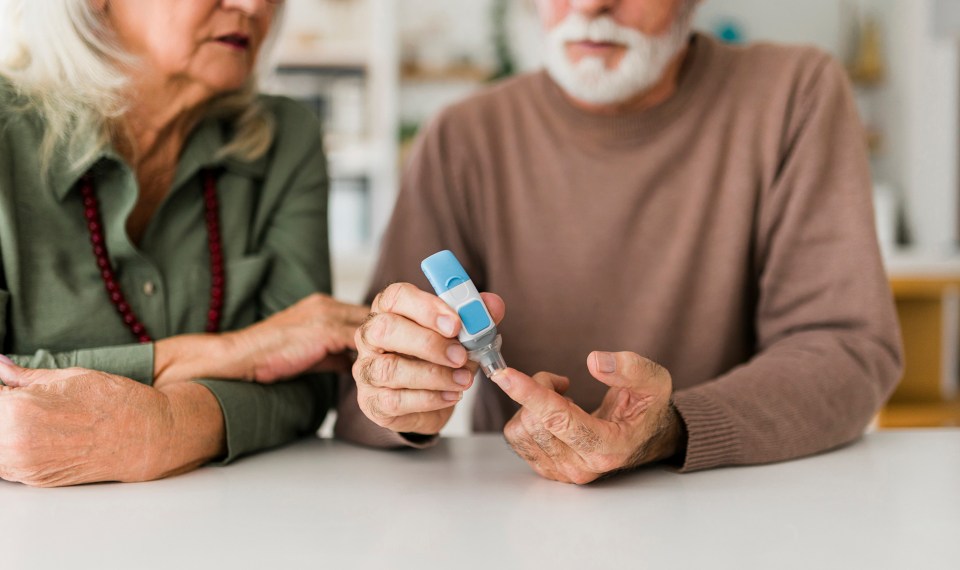There is a strong link between diabetes and stroke. Diabetes is a condition that causes high blood sugar. This chronic disease occurs when your body does not make enough insulin or doesn’t utilize insulin the way it should. This causes blood sugar levels to rise in response and can lead to serious health conditions such as heart disease, kidney disease, vision loss and stroke.
Diabetes and Stroke Risk
Eighty-seven percent of strokes are ischemic and occur when a clot in a blood vessel blocks blood flow to the brain. Hemorrhagic stroke is far less common and is the result of a blood vessel that bursts or leaks. If you have diabetes, your stroke risk is two times that of a person who does not have diabetes. According to the American Stroke Association, every two minutes an American adult with diabetes is hospitalized with stroke. You are also at risk of developing heart disease and stroke at an earlier age than individuals who do not have diabetes.
Diabetes increases stroke risk because of the way your body manages blood glucose. Almost all the food you eat is broken down into glucose to produce energy for the body. After digestion, the glucose is carried through the bloodstream to cells throughout the body. Insulin is produced by the pancreas, a pear shaped, gland-type organ located behind the stomach. The pancreas makes two hormones, insulin and glucagon, which help regulate blood sugar. After digestion, blood sugar levels in the blood rise, triggering the pancreas to release insulin. The insulin then binds to insulin receptors on the cells causing the cells to open and take in glucose. When the body fails to produce enough insulin or when the cells can’t properly utilize the insulin, blood sugar levels increase.
Chronic high blood sugar levels can damage your blood vessels. Diabetes also leads to increased fatty deposits and clots. If clots narrow or block blood vessels in the brain or neck, blood supply and oxygen flow is interrupted, causing a stroke. If you have diabetes, smoking can increase your risk of stroke. You may also have other factors that increase the risk of stroke, including:
- Extra belly fat (a waist of more than 40 inches for men and more than 35 inches for women)
- High blood pressure
- High cholesterol
Stroke Signs and Symptoms
When you have diabetes, symptoms of stroke are the same as in those who do not have diabetes. They include:
- Sudden onset of numbness or weakness in the face, arm or leg—usually on one side of the body
- Sudden confusion, difficulty speaking or trouble understanding speech
- Sudden vision problems in one or both eyes
- Sudden trouble walking including dizziness, impaired coordination or loss of balance
- Sudden onset of headache with no other obvious cause
Diabetes and Mini Stroke
Mini stroke, also called a transient ischemic attack, or TIA, presents with the same symptoms as stroke but symptoms are brief. While TIAs don’t cause permanent damage, they are serious and are considered a warning sign for future stroke.
Transient ischemic attacks are due to a blood flow blockage, but when a clot dissolves on its own or breaks free, the symptoms disappear. Typically, symptoms of a TIA last less than five minutes. Even once you are symptom-free, it is important you seek medical treatment after a TIA since one in five people go on to have a stroke within 90 days and two in five individuals who are evaluated after suspected TIA are determined to have experienced a stroke.
Recognizing Stroke Symptoms
Recognizing stroke and seeking treatment as soon as possible can be lifesaving. The acronym F.A.S.T. was designed to help identify the signs of stroke.
- F – Face. Ask the person experiencing symptoms to smile to check for facial drooping.
- A – Arms. When raising both arms, if one arm drifts downward, it is a sign of stroke.
- S – Speech. Check for slurring or garbled speech when repeating a simple phrase.
- T – Time. If any of the above symptoms are present, call 9-1-1 immediately.
Because some treatments must be initiated within a certain timeframe, it is important to note the time the symptoms first appeared. Never wait to see if symptoms subside or worsen. Call for help immediately. And don’t try to drive someone having a stroke to the hospital. Call 9-1-1 so treatment can be administered on the way.
Diabetes and Stroke Prevention
Diabetes does raise your risk of stroke, but it doesn’t mean stroke is inevitable. There are ways to reduce your risk of stroke. These include:
- Consume a heart healthy diet. Aim for 14 grams of fiber for every 1,000 calories and reduce cholesterol intake to 300 milligrams daily.
- Avoid smoking or vaping. Smoking raises your triglyceride level in the blood. It also lowers good cholesterol (HDL) and increases your risk of clots. It damages blood vessels and causes them to thicken and narrow while increasing plaque build-up in the arteries.
- Maintain a healthy weight. Being overweight or being severely obese increases your risk of stroke. It also raises your risk of atherosclerosis (narrowed and blocked arteries) and is associated with high blood pressure. If you carry your excess weight around the middle, it is even more dangerous. Increased abdominal fat places you at greater risk of high blood pressure and other health problems.
- Exercise daily. Numerous studies have shown 40 minutes of moderate to vigorous exercise three to four times a week can reduce your risk of stroke. Even a brisk walk is beneficial in lowering your risk of stroke. Physical activity can help with weight maintenance and lowering cholesterol levels and blood pressure. But be sure to check with your doctor before beginning an exercise program.
- Drink alcohol only in moderation. It is recommended you limit yourself to one drink a day if you are a woman, or two drinks daily if you are a man. Excessive alcohol consumption on a regular basis increases your risk of health conditions that can lead to stroke.
- Control your stress. You likely won’t be able to eliminate all stress, but managing your stress is good for your health. Studies indicate stress—especially stress related to work—can increase stroke risk.
- See your doctor regularly for routine check-ups and lab work. Checking A1C levels allows your doctor to see your blood sugar levels for the past three months. Monitoring blood pressure and cholesterol and treating as necessary is also helpful in avoiding stroke.
Stroke Treatment
If you arrive at the hospital within three hours of the first symptoms of an ischemic stroke, tissue plasminogen activator, tPA, may be given to break up the clot. When tPA is administered it improves your chance of full or improved stroke recovery.
Hemorrhagic stroke may require surgery to stop the bleed or an endovascular procedure to repair a weakened or burst blood vessel.
Diabetes and Post-Stroke Recovery
There is evidence that having diabetes may be associated with poorer outcomes after ischemic or hemorrhagic stroke. This includes higher mortality, worse neurological and functional outcomes, longer hospital stays, more readmissions to the hospital and greater recurrence of stroke.
Inpatient rehabilitation is beneficial for almost all who are recovering from a stroke and should start soon after a stroke. In inpatient therapy, patients receive a combination of physical, occupational and speech therapy three hours a day, five days a week. They will also receive frequent visits from physicians specializing in rehabilitation. A registered dietitian will also work with you to ensure you are managing your diabetes during your recovery.
The content of this site is for informational purposes only and should not be taken as professional medical advice. Always seek the advice of your physician or other qualified healthcare provider with any questions you may have regarding any medical conditions or treatments.



